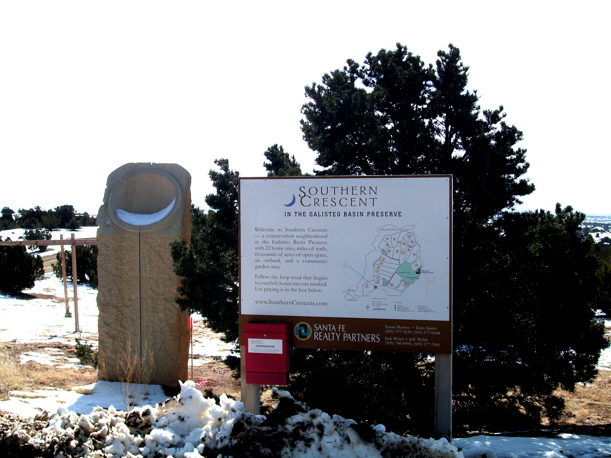
A section called Southern Crescent, where “22 home sites embrace a 100-tree orchard and community garden,” was just as I’d left it a year ago. The streets were platted and labeled with signs. Some lots were marked “sold.” But not a single residence had been built. The orchard was a field of sticks. Maybe these saplings will grow up someday to be shade trees, and maybe Southern Crescent will become a real place. But that’s the least of the developers’ grand plan.
What they say they envision is a “fine-grained, walkable community” of 965 closely spaced residences surrounding (how many times have we heard this?) a “vibrant village center” just like in a genuine, old fashioned town. There will be “a cafe, general store, post office, business incubator, outpatient medical facility, fire station, ATM, non-denominational place of worship, environmental center, and live-work space for artisans and businesses” — all the New Urbanist cliches. The high school will, of course, be “environmentally focused” and the community center will include “playfields, a library, a swimming pool, meeting spaces, and continuing-education classrooms.” They’ll probably teach acupuncture, iridology, and feng-shui.
The new town will be laid out according to “celestial alignments” — inspired, judging from an online presentation, by the mysterious Nazca Spirals of the Incas and the signs of the Zodiac. (Other inspirations include Anasazi cliff dwellings and the Alhambra.) Except for the New Age marketing, the details from the master plan look remarkably like those for the Northwest Quadrant. (Please see Sim City.) There is even an imaginary place called Happy Valley.
Maybe the motivation for all this is more quixotic than cynical. The front group for the project is a nonprofit corporation, Commonweal Conservancy, whose board overlaps with past and present members of the Trust for Public Land. They don’t hesitate to use that as a selling point. The same people also populate the board of Commonweal Communities, the for-profit subsidiary that is doing the actual development. It would be instructive to know how much money the visionaries stand to make.
Or how much they stand to lose. Before the County Commission rules on the next phase of this pipe dream, it might consider whether the old ranch really needs saving — there is no shortage of stillborn subdivisions in Santa Fe County — and whether the Village at Galisteo Basin Preserve has the slightest chance of ever attracting enough businesses to keep the 2,000 to 3,000 prospective residents from commuting 20 miles back and forth to Santa Fe. Similar plans haven’t worked in Aldea (please see Ballad of a Sad Cafe) or even in Rancho Viejo, where about all you can buy without hitting the road is a muffin and a cup of coffee.

Related Posts:
The New Urbanism Scam
Sim City
Unsustainability
Ballad of a Sad Cafe